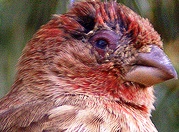Songbirds with eye infections are occasionally found at bird feeders this time of year. A bird might be observed sitting at a feeder for long  periods of time and depending on how advanced the infection is, the bird may fly away when approached or sit there blindly — allowing you to pick it up. There is treatment for this condition and there is a lot you can do to help.
periods of time and depending on how advanced the infection is, the bird may fly away when approached or sit there blindly — allowing you to pick it up. There is treatment for this condition and there is a lot you can do to help.
Avian conjunctivitis is an eye infection that can inflict many species of songbird but is most often seen in house finches. The bacteria affect the conjunctiva, the membrane surrounding the eyes, causing the tissue to swell and become irritated. As the infection spreads, the bird can become completely blind. Starvation quickly follows if not treated.
Avian conjunctivitis is a bacterial infection easily spread at bird feeders, which is why it is more prevalent this time of year. Birds can contaminate the seed simply by visiting the feeder and once a sick bird finds a feeder, it may be reluctant to leave that food source because it cannot see. Healthy birds will quickly pick up the infection and spread it to other feeders as they visit the neighborhood.
Signs of a problem are swollen, red eyes, listlessness and approachability. Birds will often sit fluffed up as their energy reserves diminish. If you see such a bird, do not wait to call us. Capture the bird immediately and place it in a box keeping it warm, dark and quiet. Call Red Creek and transport it to us as quickly as possible. We have a treatment of topical and oral antibiotics that has proven very successful at curing these birds.
Even if you do not see infected birds in your area, you can help reduce the spread of the disease by following a regular disinfection routine of your bird feeders:
” Twice each week allow the seed to empty in the feeder.
” Clean any debris and bird droppings from the feeder.
” After cleaning, soak the feeder in one part bleach to thirty parts water solution for fifteen minutes.
” Rinse and allow to completely dry before refilling the feeder with fresh seed.
It is very important to apply this routine to ALL the feeders in the area. Encourage your bird-friendly neighbors to do the same by printing and sharing this article with them.
